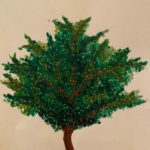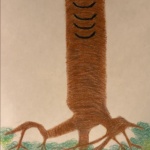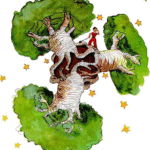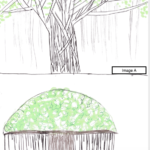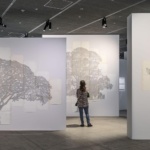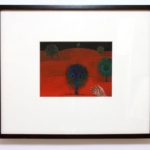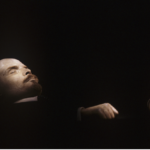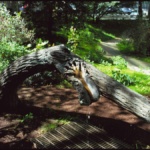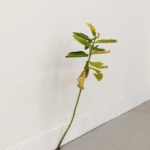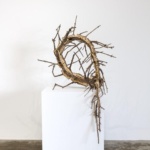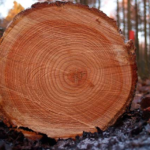Our memorial, titled “Rings of Time: A Memorial to the Trees,” was inspired by the tree rings of the world’s largest trees (by volume), the Giant Sequoias.
A member of the National Park Service was saddened by the disappearance of these enormous trees as a result of climate change. As calamity befell the Earth she proposed a memorial which would artistically represent human connection to nature, documenting an aspect of history on Earth just as redwood tree rings biologically catalogue Earth’s seasons. The National Parks Service enthusiastically agreed to funding and organizing the memorial and offered to supply a preserved redwood tree stump as the memorial’s centerpiece. Our memorial will depict the passage of time through figurative tree rings, created from sculpted trees composing a forest around a real redwood tree stump.
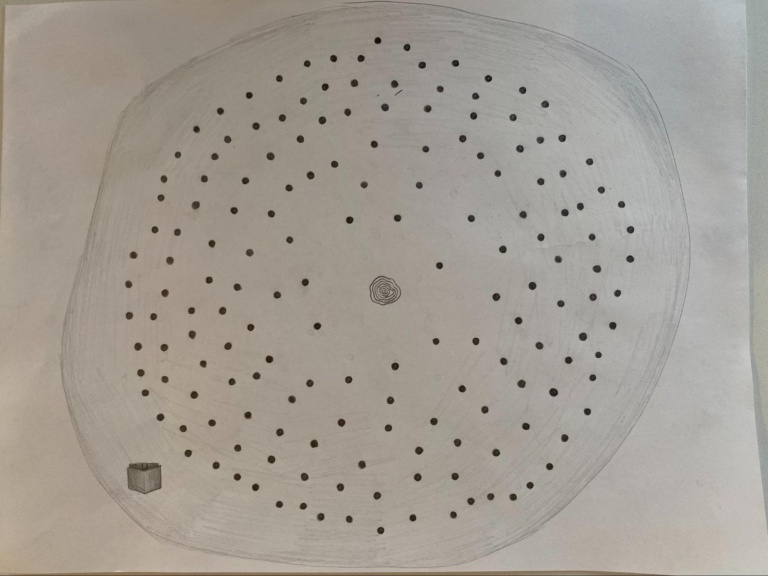
The tree sculptures will become more sparse towards the center, placing greater emphasis on the redwood tree stump in the middle. The forest will be constructed within the Argyre Planitia crater on Mars, using the greenery and familiarity of the sculpture forest to distinguish it from the red, unforgiving landscape of Mars to give our audience a sense of what we lost. Each of the tree sculptures will have their own plaque on the ground in front of them with the artist’s description of their work. The trees will be mixed randomly, and factors such as the age of the trees, although important, will not have any bearing on the trees’ location in the memorial.
As visitors walk towards the center of the forest and approach the redwood stump, there will be a thick glass covering on the ground (which can be walked on), which both exposes and protects the roots of the redwood stump from the elements and damage. The glass covering allows visitors to view the only real tree in the memorial, the stump, in its entirety. The presence of the redwood roots show our audience the difference between the artificial trees in the memorial and real trees on Earth, further emphasizing the idea that Mars’ harsh conditions and arid landscape prohibit the life of flora and fauna. By providing our visitors with both an above and underground view, we hope to show them that a tree is more than a just pretty feature of Earth, but a life sustaining entity. Additionally, we will include a ranger’s station on the grounds of the memorial. The station will be located on the edge of the memorial and will document the project’s history, ecological information about the actual trees on Earth that are being represented, the artist’s descriptions of their projects and materials, and materials actually taken from forests. This will allow visitors to learn more about the trees left behind on Earth.
Trees have been a constant force in Earth’s biosphere. We climb them, worship them, and use them to sustain ourselves. They give us oxygen and life, allowing for our presence on Earth. Our project is a memorial for trees, forcing us to remember the connection between humans and trees on Earth. The year is 2100, and the Earth, having succumbed to the pressure of climate change, can no longer support human life, forcing the human population to flee to Mars. In order to honor the trees we left behind, our team gathered artists from Earth, asking them to create a tree using both natural and artificial materials, showing us what that particular tree means to them. The artists can draw inspiration from cultural or personal sources. Our ultimate goal is to create a forest of numerous types of trees found on Earth, memorializing the natural landscape we destroyed and showing our audience the importance of remembering what we lost. The real tree stump is surrounded by fake trees, which impresses on the audience the fragility of trees, and by extension, of the planet.
Click through each gallery to see art that inspired the memorial!
The choice to create a memorial and not a monument was agreed upon at the beginning of the project because the sculpture forest is created in remembrance of the many forest monuments and trees on Earth, focusing on our lost connection with them. Because this monument is not for the war dead or those lost from mass casualty, but does represent a shared human loss, the symbolism of our memorial must deviate from traditional memorial visuals. Thus, this genre of commemorative art will rely on less prominent symbolism like tree rings and rely on its materiality to depict a place now unobtainable to us, Earth, while conveying the memorial’s message to new configurations of peoples and a transnational audience. The choice to represent individual trees and include the stories behind them was made to highlight the personal and individual nature of the loss, while their amalgamation creates a universal experience of walking through a forest. This helps honor the impact on all of Earth’s nations, promoting the message of loss to humanity as a whole, rather than specific nations or states. We know that sometimes audiences might not experience or interact with the memorial as intended. This is shown by a project done in Nicaragua, Árboles de la Vida, which was an attempt at city beautification, though citizens reacted in anger, “felling” more than 60 trees in political protest. Hopefully the open layout of our memorial, and our intent to cross cultural and political divisions, will support its universal nature.
Our memorial is interactive and is meant to be the experience of a forest walk. The forest’s footprint is roughly circular and there are no barriers to entry so visitors can create their own paths when walking around. The experience of walking through the forest is open to all and each visitor will have different interactions with the memorial. However, there are two points that visitors will be encouraged to view: the ranger station, and the tree stump at the center. As the viewer walks towards the center they experience the passage of time as trees disappear, just as they did on Earth. While visitors walk they will be reading about, looking at, touching, and even climbing the trees along their way. When visitors reach the center they will see the only aspect of the memorial which was once living, the tree stump, in an empty center. This will give them time and space to reflect on what was lost through the contrast between the tall artificial trees and the stump in the center which will be rooted into the ground. Like the Vietnam memorial by Maya Lin, there will be some for whom the walk is a “private awakening, a private awareness of that loss.” The memorial should be a place “away from political activism and ritual and toward self-exploration,” however there will also be space for people, children especially, to imagine interacting with the trees on Earth by interacting with the sculptures. While the memorial is interactive and kinetic, the only signs of life come from people. It will lack the typical forest sounds such as the chirping of birds, branches and twigs under visitors’ feet, and seed or leaves falling. This lack will help create the dissonance between the beauty of the memorial and its message so that it retains its original meaning instead of becoming a playground or amusing experience unconnected to the Earth.
The purpose of “Rings of Time” is to commemorate the trees that were destroyed through deforestation and climate change on Earth. We hope to connect visitors who were alive on Earth to their own memories of trees. Moving into the future, we hope that this memorial will show the new human population what trees were on Earth and the connections that humans and artists had with them. Through our inclusion of works by different artists around the world, our intention is to highlight different cultural legacies, stories, and histories with regard to humanity’s connection to trees. While we understand that the interpretation of this memorial may change over time, we hope those who enter this memorial will leave with an idea of trees’ natural beauty and the ever present connection with nature that characterized life on Earth– forcing visitors to contemplate and interact with the loss of our ancestral home.
